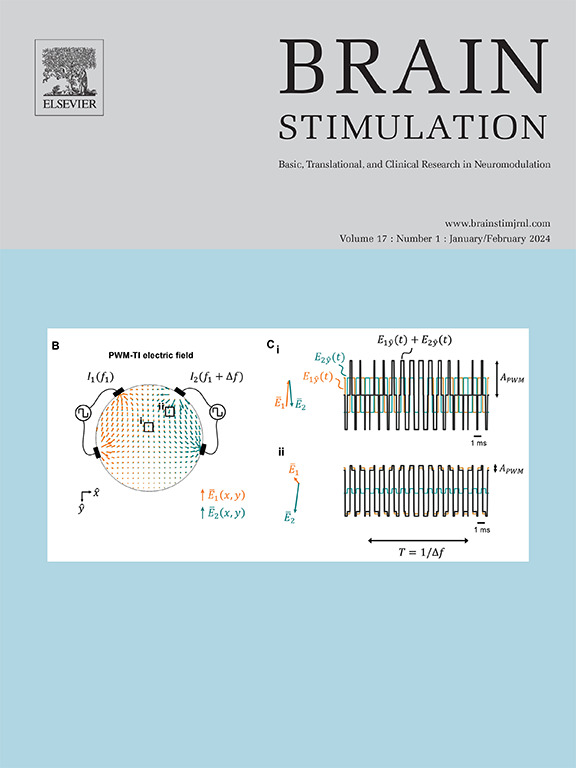颅内刺激对人局部神经血管反应的影响。
IF 8.4
1区 医学
Q1 CLINICAL NEUROLOGY
引用次数: 0
摘要
背景:脑深部电刺激(DBS)通过调节神经回路来治疗神经和精神疾病。然而,由于捕获植入导联附近微血管变化的局限性,电刺激对神经血管单位的影响仍然知之甚少。这促使我们研究心弹道波形(CBW)作为微刺激反应血管动力学的电生理替代物。方法:在DBS植入手术中,通过一个电极进行微刺激前后的两个电极(相距约600 μm)进行微电极记录(n = 193; 108例患者)。广义线性混合模型评估了基底节区和白质在1hz或100hz刺激后CBW振幅的变化。神经元活动也被分析,包括锁相到心脏周期,放电速率和模式,以及微lfp特征。分析模型将CBW振幅解释为压力驱动的血管壁扩张,从而可以估计刺激引起的血管舒张和脑血流量。结果:刺激电极100 Hz刺激后CBW幅值显著增加,而非刺激电极和1 Hz刺激后CBW幅值无显著增加。在腹侧中间核(Vim; 107±13%)、丘脑下核(STN; 79±7%)和内苍白球(GPi; 78±8%)中观察到显著的区域特异性效应,但在白质(WM; 50±14%)或网状黑质(SNr; 45±8%)中没有观察到显著的区域特异性效应。在50个记录的单单位中,18个(36%)被锁相于心周期,但刺激不会改变锁相值,刺激前后尖峰或微lfp特征的变化不随CBW的变化而变化。模型显示,Vim、STN和GPi的CBW平均增加88%,对应于脑血流的急性增加。结论:CBW记录显示,高频DBS引起区域特异性血管反应,可以模拟为局部血流的大幅增加,建立CBW振幅作为皮质下血流动力学的潜在生物标志物,以及潜在的治疗方式。本文章由计算机程序翻译,如有差异,请以英文原文为准。
The effects of intracranial stimulation on local neurovascular responses in humans
Background
Deep brain stimulation (DBS) is used to treat neurological and psychiatric disorders by modulating neuronal circuits. However, the effects of electrical stimulation on the neurovascular unit remain poorly understood due to limitations of capturing microvascular changes near implanted leads. This motivated us to investigate the cardioballistic waveform (CBW) as an electrophysiological surrogate of vascular dynamics in response to microstimulation.
Methods
Microelectrode recordings (n = 193; 108 patients) were obtained during DBS implantation surgery from two electrodes (∼600 μm apart) before and after microstimulation through one electrode. Generalized linear mixed models assessed CBW amplitude changes following 1 Hz or 100 Hz stimulation across basal ganglia regions and white matter. Neuronal activity was also analyzed, including phase-locking to the cardiac cycle, firing rates and patterns, and micro-LFP features. An analytical model interpreted CBW amplitudes as pressure-driven vessel wall expansion, enabling estimation of stimulation-evoked vasodilation and cerebral blood flow.
Results
CBW amplitudes increased significantly after 100 Hz stimulation at the stimulating electrode, but not at the non-stimulating electrode or after 1 Hz stimulation. Significant region-specific effects were observed in the ventral intermediate nucleus (Vim; 107 ± 13 %), subthalamic nucleus (STN; 79 ± 7 %), and globus pallidus internus (GPi; 78 ± 8 %), but not in white matter (WM; 50 ± 14 %) or substantia nigra pars reticulata (SNr; 45 ± 8 %). Across 50 recorded single units, 18 (36 %) were phase-locked to the cardiac cycle, but stimulation did not alter phase-locking value, and changes in spiking or micro-LFP features before versus after stimulation did not scale with CBW changes. Modelling showed that the mean 88 % CBW increase across Vim, STN, and GPi corresponds to an acute increase in cerebral blood flow.
Conclusion
CBW recordings reveal that high-frequency DBS evokes region-specific vascular responses which can be modeled as substantial increases in local blood flow, establishing CBW amplitude as a potential biomarker of subcortical hemodynamics, and a potential therapeutic modality.
求助全文
通过发布文献求助,成功后即可免费获取论文全文。
去求助
来源期刊

Brain Stimulation
医学-临床神经学
CiteScore
13.10
自引率
9.10%
发文量
256
审稿时长
72 days
期刊介绍:
Brain Stimulation publishes on the entire field of brain stimulation, including noninvasive and invasive techniques and technologies that alter brain function through the use of electrical, magnetic, radiowave, or focally targeted pharmacologic stimulation.
Brain Stimulation aims to be the premier journal for publication of original research in the field of neuromodulation. The journal includes: a) Original articles; b) Short Communications; c) Invited and original reviews; d) Technology and methodological perspectives (reviews of new devices, description of new methods, etc.); and e) Letters to the Editor. Special issues of the journal will be considered based on scientific merit.
 求助内容:
求助内容: 应助结果提醒方式:
应助结果提醒方式:


